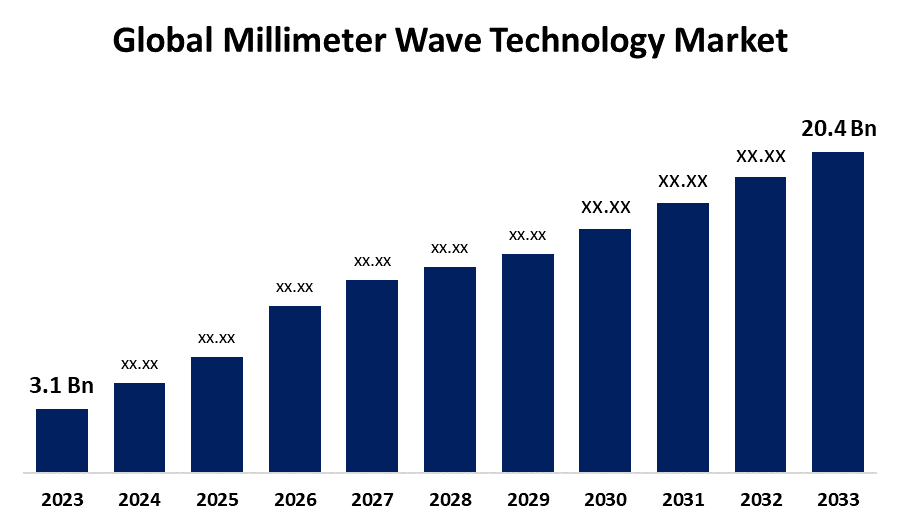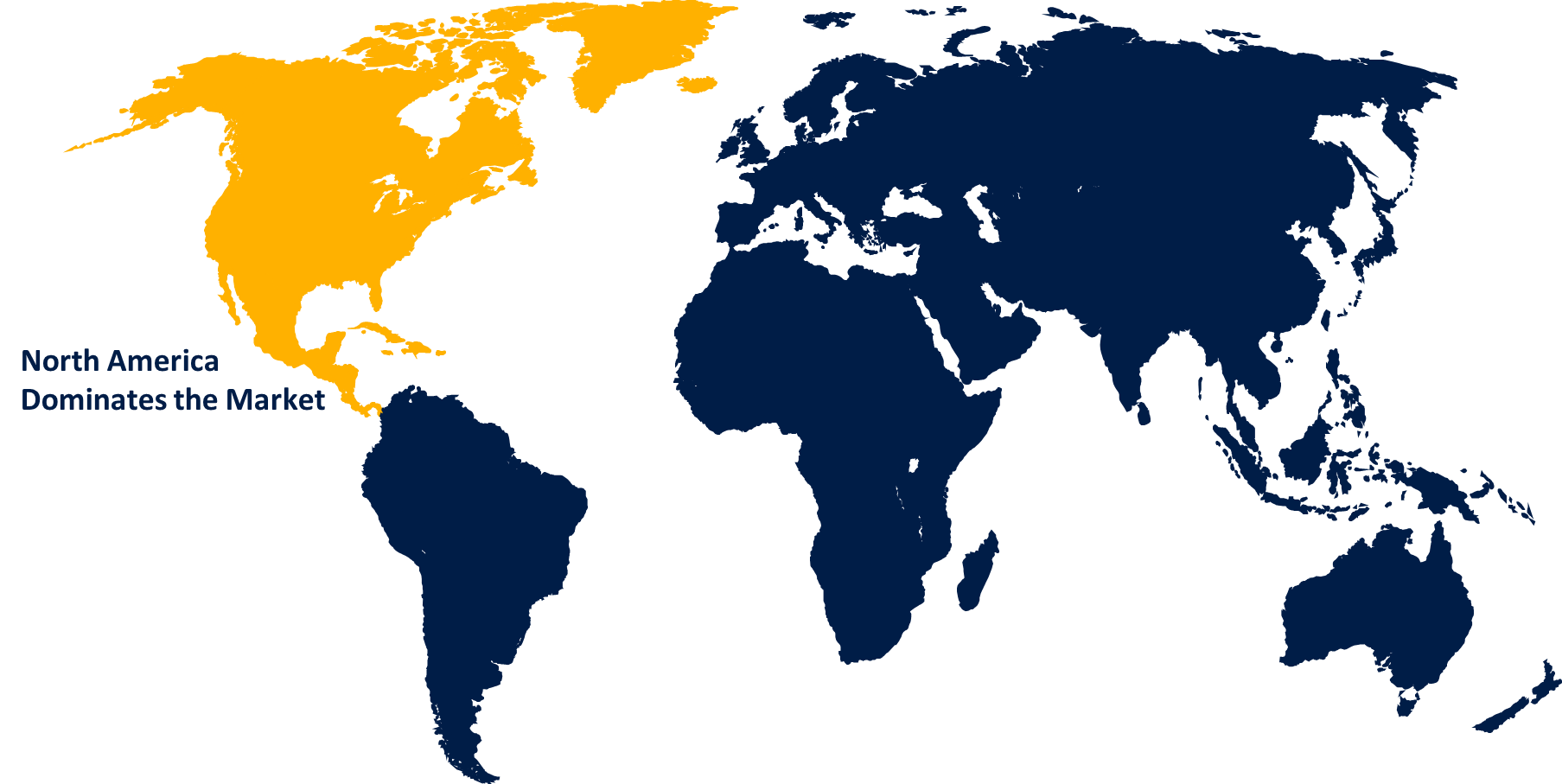Global Millimeter Wave Technology Market Size, Share, and COVID-19 Impact Analysis, By Product (Telecommunication Equipment, Imaging & Scanning Systems, and Radar & Satellite Communication Systems), By Frequency Band (V-Band, E-Band, and Others), By Application (Telecommunications, Military & Defense, Automotive & Transport, Healthcare, Electronics & Semiconductor, and Security), and By Region (North America, Europe, Asia-Pacific, Latin America, Middle East, and Africa), Analysis and Forecast 2023 - 2033
Industry: Semiconductors & ElectronicsGlobal Millimeter Wave Technology Market Insights Forecasts to 2033
- The Global Millimeter Wave Technology Market Size Was Valued at USD 3.1 Billion in 2023
- The Market Size is Growing at a CAGR of 20.7% from 2023 to 2033
- The Worldwide Millimeter Wave Technology Market Size is Expected to Reach USD 20.4 Billion by 2033
- Asia Pacific is Expected to Grow the fastest during the forecast period.

Get more details on this report -
The Global Millimeter Wave Technology Market Size is Anticipated to Exceed USD 20.4 Billion by 2033, Growing at a CAGR of 20.7% from 2023 to 2033.
Market Overview
The millimeter wave technology refers to the use of electromagnetic waves ranging from frequencies of 30 GHz to almost 300 GHz. (Cords) waves of shorter wavelengths than standard radio, so huge amounts of data can be transmitted to small areas; 5G networks, which enable ultra-fast internet with the broad bandwidth necessary to support new applications such as virtual reality and autonomous vehicles (as well as smart city infrastructure) are only possible because of millimeter wave technology. One of the primary benefits of millimeter wave technology is its ability to transmit data at high speeds, making it ideal for densely populated cities with high demand for mobile connectivity. However, because of the short wavelength, millimeter wave signals are more susceptible to obstacles such as buildings and weather, limiting their range and necessitating the use of more base stations to ensure consistent coverage. Despite these challenges, millimeter wave technology has enormous potential to transform industries that rely on fast, dependable data transmission, such as telecommunications, healthcare, and transportation. As research and development in this field continue, millimeter wave is expected to have a significant impact on the future of wireless communication and other emerging technologies.
Report Coverage
This research report categorizes the market for the global millimeter wave technology market based on various segments and regions forecasts revenue growth and analyzes trends in each submarket. The report analyses the key growth drivers, opportunities, and challenges influencing the global millimeter wave technology market. Recent market developments and competitive strategies such as expansion, product launch, and development, partnership, merger, and acquisition have been included to draw the competitive landscape in the market. The report strategically identifies and profiles the key market players and analyses their core competencies in each sub-segment of the global millimeter wave technology market.
Global Millimeter Wave Technology Market Report Coverage
| Report Coverage | Details |
|---|---|
| Base Year: | 2023 |
| Market Size in 2023: | USD 3.1 Billion |
| Forecast Period: | 2023 - 2033 |
| Forecast Period CAGR 2023 - 2033 : | 20.7% |
| 2033 Value Projection: | USD 20.4 Billion |
| Historical Data for: | 2019 - 2022 |
| No. of Pages: | 230 |
| Tables, Charts & Figures: | 115 |
| Segments covered: | By Product, By Frequency Band, By Application, By Region |
| Companies covered:: | Axxcss Wireless Solutions, Ceragon, L3Harris Technologies, Inc, Aviat Networks, Inc., BridgeWave Communications, E-Band Communications, LLC, Farran Technology, Keysight Technologies, LightPointe Communications, Inc., Millitech, Inc., NEC Corporation, QuinStar Technology, Inc., Eravant, Siklu Communication Ltd., Trex Enterprises Corporation, and Others |
| Pitfalls & Challenges: | COVID-19 Empact, Challenge, Future, Growth, & Analysis |
Get more details on this report -
Driving Factors
Proliferation of Wireless Backhaul and increasing adoption of 5G networks
Millimeter wave bands are a perfect fit for the high-capacity requirements of 5G enhanced mobile broadband. They can also be used as a wireless backhaul option, perfect for the rapidly growing number of cell sites-especially in highly congested areas. Millimeter wave technology is gaining traction to be applied across wireless backhaul networks because of increased demand for faster access to the internet and 5G. mmWave technology provides high-capacity wireless backhaul solutions. This implies that the data transmission rates from base stations to the core network will be higher, which becomes vital to handling massive data traffic produced by various applications such as 5G, VR, and IoT, among others.
Restraining Factors
Harmful Impact on The Environment
Significant space consumption by transmission towers contributes to large-scale deforestation, primarily in rural areas; and several materials, including SiGe, GaAs, InP, and GaN, which are used in millimeter wave frequency circuitries are toxic and their prolonged use can be harmful to the environment.
Market Segmentation
The global millimeter wave technology market share is classified into product, frequency band, and application.
- The telecommunication equipment segment is expected to hold the largest share of the global millimeter wave technology market during the forecast period.
Based on the product, the global millimeter wave technology market is categorized into telecommunication equipment, imaging & scanning systems, and radar & satellite communication systems. Among these, the telecommunication equipment segment is expected to hold the largest share of the global millimeter wave technology market during the forecast period. Millimeter wave technology is essential for increasing spectrum utilization and bandwidth. The application of millimeter wave technology to telecommunications equipment has transformed the telecom industry. Additionally, millimeter waves are transforming fifth-generation (5G) cellular communication due to their ability to transfer gigabits of data per second. The growing demand for millimeter wave technology in 5G applications is expected to drive the growth of the telecommunications equipment segment during the forecast period.
- The E-band segment is expected to grow at the fastest CAGR during the forecast period.
Based on the frequency band, the global millimeter wave technology market is categorized into V-band, E-band, and others. Among these, the E-band segment is expected to grow at the fastest CAGR during the forecast period. The growth in the segment is attributed to the availability of unconstrained spectrum in the E-band that enables cost-effective deployment of wireless networks for high-speed data transfer. The E-band will become indispensable in 5G networks, taking into consideration the increased demand for high-bandwidth applications such as cloud computing, video streaming, and IoT for faster data rates with less latency. Generally, the employment of E band millimeter wave technology is considered to give high-speed data transfer and low latency due to its cost-effectiveness in deploying the technology; therefore, it has become an enticing alternative for a wide range of applications covering 5G wireless networks, wireless backhaul, and indoor wireless networks.
- The telecommunications segment is expected to grow at the fastest CAGR during the forecast period.
Based on the application, the global millimeter wave technology market is categorized into telecommunications, military & defense, automotive & transport, healthcare, electronics & semiconductors, and security. Among these, the telecommunications segment is expected to grow at the fastest CAGR during the forecast period. The segment's expansion can be attributed to increased demand for high-speed data transfer and communication from the residential and commercial sectors, including data centers and IT offices. Additionally, 5G providers are looking for infrastructure technologies that will allow them to achieve high bandwidth data transmission while maintaining low costs and power consumption, increasing demand for millimeter wave technology from the telecommunications segment and propelling the segment's growth.
Regional Segment Analysis of the Global Millimeter Wave Technology Market
- North America (U.S., Canada, Mexico)
- Europe (Germany, France, U.K., Italy, Spain, Rest of Europe)
- Asia-Pacific (China, Japan, India, Rest of APAC)
- South America (Brazil and the Rest of South America)
- The Middle East and Africa (UAE, South Africa, Rest of MEA)
North America is projected to hold the largest share of the global millimeter wave technology market over the forecast period.

Get more details on this report -
North America is projected to hold the largest share of the global millimeter wave technology market over the forecast period. The North American millimeter wave technology market has grown due to the region's increased acceptance of technology. North American countries, such as the U.S. and Canada, are notable early adopters of new and emerging technologies. Additionally, the region is home to several key market players who are capitalizing on the region's growth. As a result, these factors create opportunities for millimeter wave technology in various applications across the region, driving its growth over the forecast period.
Asia Pacific is expected to grow at the fastest CAGR growth of the global millimeter wave technology market during the forecast period. The rapid growth of the Asia Pacific region can be attributed to the advancement and upgrading of its telecom infrastructures. Also, the rapid deployment of 5G technology in major countries such as South Korea and India drives up demand for millimeter wave technology. Additionally, the installation of new telecom equipment based on millimeter wave technology is expected to drive the regional market at a rapid pace.
Competitive Analysis:
The report offers the appropriate analysis of the key organizations/companies involved within the global millimeter wave technology market along with a comparative evaluation primarily based on their product offering, business overviews, geographic presence, enterprise strategies, segment market share, and SWOT analysis. The report also provides an elaborative analysis focusing on the current news and developments of the companies, which includes product development, innovations, joint ventures, partnerships, mergers & acquisitions, strategic alliances, and others. This allows for the evaluation of the overall competition within the market.
List of Key Companies
- Axxcss Wireless Solutions
- Ceragon
- L3Harris Technologies, Inc
- Aviat Networks, Inc.
- BridgeWave Communications
- E-Band Communications, LLC
- Farran Technology
- Keysight Technologies
- LightPointe Communications, Inc.
- Millitech, Inc.
- NEC Corporation
- QuinStar Technology, Inc.
- Eravant
- Siklu Communication Ltd.
- Trex Enterprises Corporation
- Others
Key Market Developments
- In February 2024, Ceragon has announced plans to unveil a new lineup of industry-first innovations at Mobile World Congress (MWC) 2024. Highlights include a live demonstration of Ceragon's upcoming millimeter wave technology based on the Neptune SoC, showcasing an unparalleled 4000 MHz channel bandwidth, 16K QAM, which, when combined with XPIC and MIMO technologies, enables a 100 Gbps mmW link, far exceeding competitor capabilities.
- In January 2024, Aviat Networks has announced a strategic collaboration with PT Smartfren Telecom Tbk to provide high-speed, ultra-reliable wireless connectivity, private wireless indoor and outdoor networks, and industry digitalization and automation services to private network customers throughout Indonesia.
Key Target Audience
- Market Players
- Investors
- End-users
- Government Authorities
- Consulting And Research Firm
- Venture capitalists
- Value-Added Resellers (VARs)
Market Segment
This study forecasts revenue at global, regional, and country levels from 2020 to 2033. Spherical Insights has segmented the global millimeter wave technology market based on the below-mentioned segments:
Global Millimeter Wave Technology Market, By Product
- Telecommunication Equipment
- Imaging & Scanning Systems
- Radar & Satellite Communication Systems
Global Millimeter Wave Technology Market, By Frequency Band
- V-Band
- E-Band
- Others
Global Millimeter Wave Technology Market, By Application
- Telecommunications
- Military & Defense
- Automotive & Transport
- Healthcare
- Electronics & Semiconductor
- Security
Global Millimeter Wave Technology Market, By Regional
- North America
- US
- Canada
- Mexico
- Europe
- Germany
- UK
- France
- Italy
- Spain
- Russia
- Rest of Europe
- Asia Pacific
- China
- Japan
- India
- South Korea
- Australia
- Rest of Asia Pacific
- South America
- Brazil
- Argentina
- Rest of South America
- Middle East & Africa
- UAE
- Saudi Arabia
- Qatar
- South Africa
- Rest of the Middle East & Africa
Need help to buy this report?